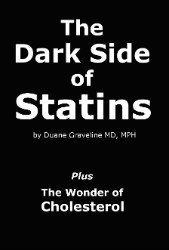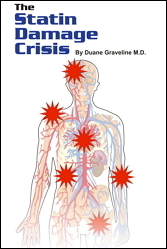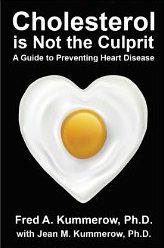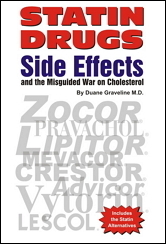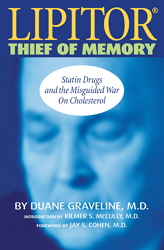Anti-Oxidation and Mitochondrial Damage 1 of 2
 By Duane Graveline MD, MPH
By Duane Graveline MD, MPH
Statins and Mitochondrial Damage Part 9 of 11
"You can't live with it, and you can't live without it." comes very close to describing our love / hate relationship with the oxygen in the air around us. On one hand it is absolutely vital for life as the basis for energy production. On the other hand, the oxidizing tendency of oxygen with its production of highly energetic radicals has necessitated the evolution of our powerful anti-oxidant system to minimize the oxidative damage suffered by our tissues and, more importantly, our mitochondrial DNA.
Most textbooks define oxidation as a chemical reaction that often produces damaging free radicals by the transfer of electrons. Antioxidants help remove these free radicals thereby minimizing tissue damage. Examples of anti-oxidants are glutathione, vitamins C and E, Coenzyme Q10, superoxide dismutase, catalase and various peroxidases. Any substance that inhibits the bioavailability of antioxidants, such as the inhibitory effect of statin drugs on Coenzyme Q10, may damage our DNA, especially vulnerable, because of the immediate proximity to high oxygen levels in our mitochondrial DNA.
Initial scientific interest in oxidation started because of interest in preventing the damage of rust. Soon this interest was extended to studying the process of preventing rancidity of fats in storage, but it was the antioxidant activity of vitamins A, C and E that revolutionized the field and pointed to the critical role of antioxidants in human biochemistry.
The use of oxygen as part of the process for generating metabolic energy produces highly energetic radicals known as reactive oxygen species ( ROS ). Since reactive oxygen species do have some useful functions in cells, the function of antioxidant systems is not to remove oxidants entirely, but instead to keep them at an optimum level.
The reactive oxygen species produced in cells include hydrogen peroxide, hypochlorous acid, and free radicals such as the hydroxyl radical and the superoxide ion. These oxidants can damage cells by starting chemical chain reactions such as lipid peroxidation, or by oxidizing DNA or proteins. Damage to DNA can cause mutations, if not reversed by DNA repair mechanisms.
Of particular importance in this process is the reduction of ubiquinol (Coenzyme Q10) in complex III, where electrons can jump directly to oxygen, forming superoxide ions instead of taking the usual electron transfer path. These interactions, that form oxidants are complex and many, are still not completely understood.
Antioxidants have both independent and interdependant effects. While their individual, independent actions are quite well established, the interdependent actions, in many cases, remain to be elucidated. The action of one antioxidant may depend upon the availability and proper concentration of another antioxidant as well as its own special sensitivity to a particular reactive oxygen species and its own concentration.
Other antioxidants will depend upon the bioavailability of such elements as selenium to have proper activity. Selenium has long been known to function as an antioxidant nutrient although completely lacking in such activity by itself.
Although the antioxidants as a group are similar in their reducing effects, many have individual characteristics that are important to note in dealing with reactive oxygen species, Ascorbic acid (vitamin C) has been discussed in my third book, the Statin Damage Crisis, and in my fourth book, Statins and Mitochondrial Damage, soon to be available.
Vitamin C functions as a reducing agent and is available only from our diet. Our inability to synthesize this substance is of critical importance, particularly when elderly or infirm or unable to take in a proper diet. Supplementation is vital in many cases and the amounts are frequently inadequate, and need can change rather rapidly under stress conditions. It functions only as a reducing agent with effects on ROS that, despite numerous studies, remain theoretical.
Another important antioxidant, glutathione, shares vitamin C's role of functioning as a reducing agent. Glutathione is not required in the diet and is instead readily synthesized in our cells. Due to its usual high tissue concentration, glutathione is one of the most important cellular antioxidants. Most important of the glutathiones are the glutathione peroxidases which contain four selenium co-factors, having a major role in hydrogen peroxide breakdown.
Duane Graveline MD MPH
Former USAF Flight Surgeon
Former NASA Astronaut
Retired Family Doctor


